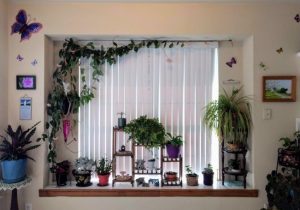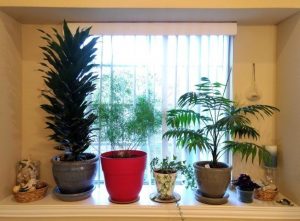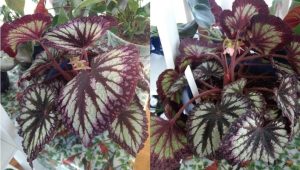by Karen Gibson, Denton County Master Gardener Association
A common complaint from gardeners is that they can grow any plant outside, but they seem to kill any and all houseplants. If you are a successful outdoor gardener, though, you have developed the skills needed to succeed in growing houseplants by putting into practice three strategies:
- Identify the conditions or microclimates where the plant will grow
- Apply knowledge of plant’s requirements for optimum growth
- Observe the plant’s health at least weekly
Microclimates
Microclimates are the weather conditions found in small, localized areas. They include level of sunlight, humidity, soil moisture, air movement, and temperature.
The rainforest understory is the natural habitat of many of our most popular and successful houseplants and, as such, they thrive in indirect lighting, warmer temperatures, and higher humidity. Recreating that microclimate as much as possible will increase your chance of a houseplant success story. Consider factors such as ambient room temperature, cold drafts (drafty windows, air conditioning vents), hot drafts (heat vents), and humidity levels in each room.

Sunlight
Think about the sunlight-based microclimates you have identified in your landscape and how they impacted successful plant selection and care. They could include:
- The south yard that receives sunshine year round
- The east yard with a mature tree providing shade all morning, but receiving full afternoon sun
- The narrow north yard between your house and your fence line that never sees any sunshine
- The west yard that is shaded by your house in the morning, but receives full sun from early afternoon until sunset.
Each of these areas has its own unique growing conditions that, as a successful gardener, you have learned to take into consideration when selecting your plantings. The same is true inside your house. Using the scenario above for the outside conditions, your inside microclimates would be:
- The south windows that receive full direct sun from mid-morning to late-afternoon
- The east windows that receive indirect/filtered light (shade from the mature tree) in the morning and indirect light in the afternoon as the sun moves to the other side of your house
- The north windows that receives only indirect lighting year round
- The west windows that receive direct afternoon/evening light when the sun is at its hottest
Each of these areas supports different plants. If you try to grow a plant that needs indirect light in the south window, it will likely perish.
Temperature
Plants require a minimum temperature of 55°F and most are happier with it a good bit warmer. If we are experiencing a particularly cold winter here in North Texas (or if you move to a cold climate), move houseplants away from cold windows or areas near outside doors in the winter.
Air Movement
Plants do not like cold drafts (or extremely hot drafts). Keep away from active heating or cooling vents. But plants do benefit from additional air circulation (such as a slow moving fan) in order to deter possible pest infestations or fungus growth, especially closely grouped plants.

Humidity
During the heating and cooling seasons, the air conditioning and heat lowers the humidity level of our houses. To raise the humidity level for your plant, you can group several plants together. Another way is to set your plants in a tray of water – be sure to raise them up out of the water with decorative rocks or some other means. They need humidity, not wet feet. Another option is to mist plants daily with a spray bottle. Be sure to check information about your specific plant – some plants, like African violets, do not tolerate wet leaves. Lastly, the bathroom and kitchen generally have higher humidity levels, making them a good location for certain plants, like ferns, which really need that extra humidity.
Water Levels
Is the soil too dry or too wet? Overwatering is the #1 mistake made – more plants have been killed from overwatering than from being too dry. Only water when your plant needs it (visibly drooping) or the soil is dry to the touch – the “stick your finger in the dirt” is the best way to tell! Most plants need less frequent watering in the fall/winter during their dormant stage and more watering during their active growth time of spring/summer. If your plant sits in a very warm area with direct sunlight, it is going to need more frequent watering than a plant that receives only indirect light.
Knowledge
Knowledge is power. Know your plant – research its needs, its care requirements, and its native habitat. Choose plants to fit your house. It’s easier to choose the right plant than it is to try to change your home’s growing conditions. There are many books and online resources that will provide the information you need for your plants (see Resources for some I have found helpful). Knowing about your plant BEFORE you purchase it will save you time, money, and potential heartache.
When considering potential plants, keep in mind that some houseplants are toxic to young children and pets. Surprisingly, these plants include some of the most popular houseplants, including Peace Lilies, Poinsettia, English Ivy, and Pothos. Poisoning can occur in multiple ways:
- Eating or touching the leaves
- Eating the berries, blossoms, or roots
- Contact with sap or juices from the plant or roots
- Eating the plant’s soil
- Drinking water from the plant tray
If you have toddlers, pets, or even elderly family members with dementia, it’s best to limit your plant choices to those that are nontoxic. The plant tags provided by the big box stores and most nurseries will not include this information, so consult a reliable online resource before purchasing.

Observe Your Plant
Ever heard that talking to your plants helps them grow? The real secret is that is makes you take a good, careful look at them. Most gardeners make a daily or weekly walk thru of their gardens looking for potential issues, not to mention enjoying the visual and tangible fruits of their labor. Think of your houseplants as your indoor year-round garden and do the same. Because we walk past our indoor plants multiple times each day, it’s easy for them to blend into the background and we don’t really notice them. Make a habit of observing each plant at least once a week. Does it look happy? Is it leaning towards the light? If so, remember to quarter turn the plant each time you water it so that it grows evenly. Are the leaves an unnatural color? It might need a different location, either more or less light.
Keep your plants clean – trim away any dead leaves or spent blossoms. Leaving debris creates a haven for pests. Check for possible pest infestations – webs or small white fuzzy spots on or under the leaves, along the stems, are just a couple of indicators that you have a pest problem. Research the common pest / disease symptoms so you can deal with any issues early, before the problem spreads to all your plants. If you find a pest issue, isolate that plant until you are sure it’s clean and healthy again.
With an understanding of the microclimates in your home, knowledge about your plants, choosing the proper plants for your home, and regular observation, you too can boast of a green thumb. Pretty soon all your brown thumb friends will be asking you for advice!
Resources
Online & Downloadable PDFs
University of Wisconsin – Madison, Division of Extension
“Houseplant Care”
https://hort.extension.wisc.edu/articles/houseplant-care/
University of Maryland Extension, Home & Garden Information Center
“Houseplants – Seasonal”
https://extension.umd.edu/hgic/topics/houseplants-seasonal
Clemson Cooperative Extension, Home & Garden Information Center
“Common Houseplant Insects & Related Pests”
https://hgic.clemson.edu/factsheet/common-houseplant-insects-related-pests/
Cornell University, Cooperative Extension Rockland County
“Poisonous Plants around the Home”
http://rocklandcce.org/resources/poisonous-plants-around-the-home
“Houseplant Pest Management”
http://rocklandcce.org/resources/houseplant-pest-management
“Environmental Houseplant Problems”
http://rocklandcce.org/resources/environmental-house-plant-problems
University of Arkansas, Cooperative Extension Service
“Care of Houseplants”
https://s3.amazonaws.com/assets.cce.cornell.edu/attachments/1280/Care_of_Houseplants.pdf?1406053613
Books
Rodino, Heather (2019). How to Houseplant: A Beginner’s Guide to Making and Keeping Plant Friends. New York, Sterling Publishing
Pleasant, Barbara (2005). The Complete Houseplant Survival Manual: Essential Know-how for Keeping (Not Killing!) More Than 160 Indoor Plants. Storey Publishing
Article of Interest
University of Washington
“Researchers develop a new houseplant that can clean your home’s air”
https://www.washington.edu/news/2018/12/19/new-houseplant-can-clean-air/









.jpg)







